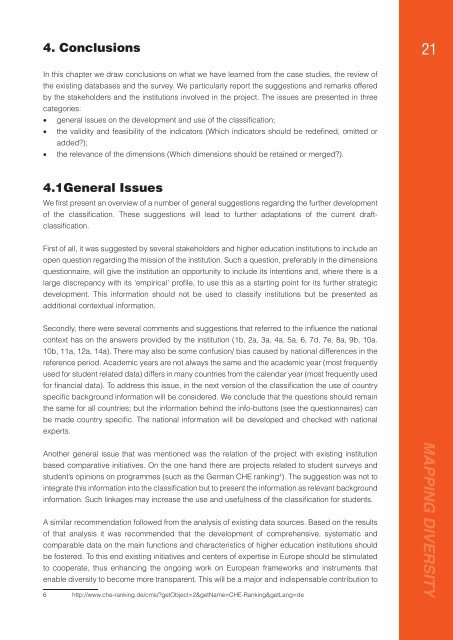Mapping Diversity: Developing a European Classification of ... - U-Map
Mapping Diversity: Developing a European Classification of ... - U-Map
Mapping Diversity: Developing a European Classification of ... - U-Map
You also want an ePaper? Increase the reach of your titles
YUMPU automatically turns print PDFs into web optimized ePapers that Google loves.
4. Conclusions<br />
21<br />
In this chapter we draw conclusions on what we have learned from the case studies, the review <strong>of</strong><br />
the existing databases and the survey. We particularly report the suggestions and remarks <strong>of</strong>fered<br />
by the stakeholders and the institutions involved in the project. The issues are presented in three<br />
categories:<br />
• general issues on the development and use <strong>of</strong> the classifi cation;<br />
• the validity and feasibility <strong>of</strong> the indicators (Which indicators should be redefi ned, omitted or<br />
added?);<br />
• the relevance <strong>of</strong> the dimensions (Which dimensions should be retained or merged?).<br />
4.1General Issues<br />
We fi rst present an overview <strong>of</strong> a number <strong>of</strong> general suggestions regarding the further development<br />
<strong>of</strong> the classifi cation. These suggestions will lead to further adaptations <strong>of</strong> the current draftclassifi<br />
cation.<br />
First <strong>of</strong> all, it was suggested by several stakeholders and higher education institutions to include an<br />
open question regarding the mission <strong>of</strong> the institution. Such a question, preferably in the dimensions<br />
questionnaire, will give the institution an opportunity to include its intentions and, where there is a<br />
large discrepancy with its ‘empirical’ pr<strong>of</strong>i le, to use this as a starting point for its further strategic<br />
development. This information should not be used to classify institutions but be presented as<br />
additional contextual information.<br />
Secondly, there were several comments and suggestions that referred to the infl uence the national<br />
context has on the answers provided by the institution (1b, 2a, 3a, 4a, 5a, 6, 7d, 7e, 8a, 9b, 10a.<br />
10b, 11a, 12a, 14a). There may also be some confusion/ bias caused by national differences in the<br />
reference period. Academic years are not always the same and the academic year (most frequently<br />
used for student related data) differs in many countries from the calendar year (most frequently used<br />
for fi nancial data). To address this issue, in the next version <strong>of</strong> the classifi cation the use <strong>of</strong> country<br />
specifi c background information will be considered. We conclude that the questions should remain<br />
the same for all countries; but the information behind the info-buttons (see the questionnaires) can<br />
be made country specifi c. The national information will be developed and checked with national<br />
experts.<br />
Another general issue that was mentioned was the relation <strong>of</strong> the project with existing institution<br />
based comparative initiatives. On the one hand there are projects related to student surveys and<br />
student’s opinions on programmes (such as the German CHE ranking 4 ). The suggestion was not to<br />
integrate this information into the classifi cation but to present the information as relevant background<br />
information. Such linkages may increase the use and usefulness <strong>of</strong> the classifi cation for students.<br />
A similar recommendation followed from the analysis <strong>of</strong> existing data sources. Based on the results<br />
<strong>of</strong> that analysis it was recommended that the development <strong>of</strong> comprehensive, systematic and<br />
comparable data on the main functions and characteristics <strong>of</strong> higher education institutions should<br />
be fostered. To this end existing initiatives and centers <strong>of</strong> expertise in Europe should be stimulated<br />
to cooperate, thus enhancing the ongoing work on <strong>European</strong> frameworks and instruments that<br />
enable diversity to become more transparent. This will be a major and indispensable contribution to<br />
6 http://www.che-ranking.de/cms/?getObject=2&getName=CHE-Ranking&getLang=de<br />
MAPPING DIVERSITY

















